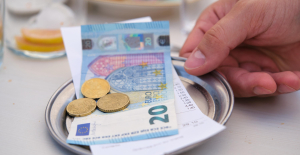Sascha was recently in the Netherlands. A few days short vacation. The Netherlands is not exactly considered the pinnacle of gastronomy. Unfortunately, because in our opinion there is neither good nor bad country cuisine. On the other hand, there are colleagues who cook differently: some well and with selected ingredients, others perhaps carelessly with ingredients from the discounter.
As passionate chefs, we eat almost everything that is put in front of us. To clear up a prejudice here: As a chef in the upscale gastronomy, you don't feed yourself exclusively with hand-massed Wagyu beef and West Swedish lobster. Rather the opposite is true. We cooks often suffer from a lack of time and an abundance of things to get done, which is why we like to grab snacks between the doors that health experts recommend only with reservations. Or, to come back to Sascha's short vacation: Of course, Sascha ate Frikandel Spezial in the Netherlands, the national dish of our neighbors: fried meat rolls, buried under ketchup, mayonnaise and onions. If you bring cravings with you: darn irresistible. Incidentally, Sascha is not afraid to pull a frikandel from a gas station vending machine, where it has probably been kept warm in a drawer with a viewing window for so long that you wouldn't want to know.
The frikandel – it can be made from beef, pork or even horsemeat – is very popular in the Netherlands, Belgium and northern France. In Germany, they are most likely associated with a bratwurst. But that leads in the wrong direction, because a frikandel sausage roll is a pasty mass and not a bratwurst, and certainly not a fresh one made from ground pork. The question that ambitious restaurateurs like us inevitably ask themselves: Can a frikandel also be prepared in such a way that it is not fast food, but quality food? Answer: Of course.
You need: 250 grams of ground beef and 250 grams of ground pork from your trusted butcher. (You know our principle: the better the ingredients, the greater the pleasure.) 60 grams of finely chopped parsley. 80 grams of finely grated white toast bread without crust (technical term: mie de pain). three eggs A heaped teaspoon of mild paprika powder. A clove of finely chopped garlic. Two shallots, finely diced. 90 milliliters of liquid, cold cream. 40 milliliters cold stock (vegetable, beef or poultry). Salt and pepper.
In a blender, combine eggs, shallots, garlic, parsley, paprika, grated bread, heavy cream and broth. You have chilled the blender attachment in the refrigerator for two to three hours beforehand. Mix once on the highest level. Then add the meat and mix well again. Sharpness desired? Then add chili to the mass before blending. Now you have a creamy mass, comparable to meat loaf. If you didn't chill the attachment beforehand, the rotation of the blender - which generates heat - would cause the fat and egg whites to separate, and we don't want that. Season with salt and pepper and refrigerate for an hour to set.
Then place the meat mass on a piece of cling film and roll it up in the film like a long candy. Cut the roll into eight sausages. Next, wrap each one additionally in aluminum foil. Now put a pot of water on, bring the water to the boil and cook the wrapped rolls for eight minutes. Admittedly, that sounds complicated, but we want to have a reasonable Frikandel on the table. When the eight minutes are up, take the rolls out of the pot and place them briefly in ice-cold water. Now remove the foil and fry the rolls in sunflower oil or clarified butter. Golden brown and crispy. Finally, garnish the sausage with mayonnaise, ketchup and red onions, as desired. And there it is in front of you: The Frikandel of your life.
Walter Stemberg and his son Sascha run the star restaurant "Haus Stemberg" in Velbert, whose star was confirmed in the Michelin guide for the ninth year in a row. In 2021, the house was awarded "Restaurant of the Year 2021" by the magazine "Der Feinschmecker". In WELT am Sonntag they write every week about the basics of cooking, from the right kitchen equipment to the question of how to recognize a good butcher or fishmonger. All episodes to read online: www.welt.de/kochschule

 Rishi Sunak wants a tobacco-free UK
Rishi Sunak wants a tobacco-free UK In Africa, the number of millionaires will boom over the next ten years
In Africa, the number of millionaires will boom over the next ten years Iran's attack on Israel: these false, misleading images spreading on social networks
Iran's attack on Israel: these false, misleading images spreading on social networks Iran-Israel: David Cameron wants the G7 to impose “coordinated sanctions” on Iran
Iran-Israel: David Cameron wants the G7 to impose “coordinated sanctions” on Iran New generation mosquito nets prove much more effective against malaria
New generation mosquito nets prove much more effective against malaria Covid-19: everything you need to know about the new vaccination campaign which is starting
Covid-19: everything you need to know about the new vaccination campaign which is starting The best laptops of the moment boast artificial intelligence
The best laptops of the moment boast artificial intelligence Amazon invests 700 million in robotizing its warehouses in Europe
Amazon invests 700 million in robotizing its warehouses in Europe Solar panels: French manufacturer Systovi announces the cessation of its activities due to “Chinese dumping”
Solar panels: French manufacturer Systovi announces the cessation of its activities due to “Chinese dumping” Tesla: canceled in court, Musk's huge compensation plan will again be submitted to shareholders
Tesla: canceled in court, Musk's huge compensation plan will again be submitted to shareholders Two, three or a hundred euros: who are the most generous customers with tips?
Two, three or a hundred euros: who are the most generous customers with tips? Boeing safety examined in US Senate, after whistleblower's revelations
Boeing safety examined in US Senate, after whistleblower's revelations Immersion among the companions of the Liberation
Immersion among the companions of the Liberation Provence-Alpes-Côte d’Azur releases several hundred thousand euros for the promotion of the work of Marcel Pagnol
Provence-Alpes-Côte d’Azur releases several hundred thousand euros for the promotion of the work of Marcel Pagnol A palm of honor distinguishes Studios Ghibli for all of their work
A palm of honor distinguishes Studios Ghibli for all of their work Gaby, a new play by Pagnol adapted into a comic strip
Gaby, a new play by Pagnol adapted into a comic strip Skoda Kodiaq 2024: a 'beast' plug-in hybrid SUV
Skoda Kodiaq 2024: a 'beast' plug-in hybrid SUV Tesla launches a new Model Y with 600 km of autonomy at a "more accessible price"
Tesla launches a new Model Y with 600 km of autonomy at a "more accessible price" The 10 best-selling cars in March 2024 in Spain: sales fall due to Easter
The 10 best-selling cars in March 2024 in Spain: sales fall due to Easter A private jet company buys more than 100 flying cars
A private jet company buys more than 100 flying cars This is how housing prices have changed in Spain in the last decade
This is how housing prices have changed in Spain in the last decade The home mortgage firm drops 10% in January and interest soars to 3.46%
The home mortgage firm drops 10% in January and interest soars to 3.46% The jewel of the Rocío de Nagüeles urbanization: a dream villa in Marbella
The jewel of the Rocío de Nagüeles urbanization: a dream villa in Marbella Rental prices grow by 7.3% in February: where does it go up and where does it go down?
Rental prices grow by 7.3% in February: where does it go up and where does it go down? Europeans: the schedule of debates to follow between now and June 9
Europeans: the schedule of debates to follow between now and June 9 Europeans: “In France, there is a left and there is a right,” assures Bellamy
Europeans: “In France, there is a left and there is a right,” assures Bellamy During the night of the economy, the right points out the budgetary flaws of the macronie
During the night of the economy, the right points out the budgetary flaws of the macronie Europeans: Glucksmann denounces “Emmanuel Macron’s failure” in the face of Bardella’s success
Europeans: Glucksmann denounces “Emmanuel Macron’s failure” in the face of Bardella’s success These French cities that will boycott the World Cup in Qatar
These French cities that will boycott the World Cup in Qatar Union Bordeaux Bègles-Clermont: at what time and on which channel to follow the Top 14 clash?
Union Bordeaux Bègles-Clermont: at what time and on which channel to follow the Top 14 clash? Football: Ada Hegerberg extends at OL until 2027
Football: Ada Hegerberg extends at OL until 2027 Basketball: suspended for life from NBA for fixing his match
Basketball: suspended for life from NBA for fixing his match Paris 2024 Olympic Games: boxer Estelle Mossely wants to parade on the Seine as a flag bearer
Paris 2024 Olympic Games: boxer Estelle Mossely wants to parade on the Seine as a flag bearer


















